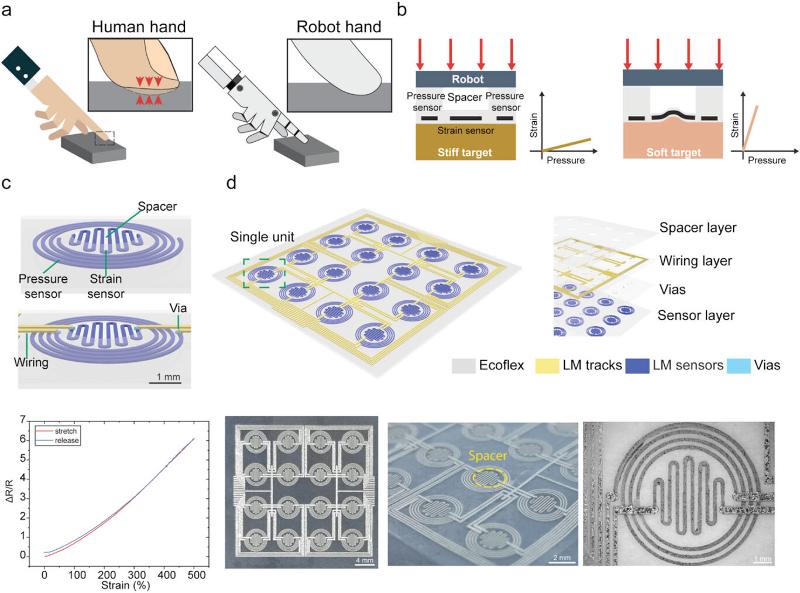In a groundbreaking development, researchers at the Ecole Polytechnique Fédérale de Lausanne (EPFL) have created a soft artificial sensory skin that can accurately determine an object's compliance. This innovative technology mimics the human perception of softness, enabling robots to perform delicate tasks and revolutionizing the field of robotics and prosthetics. Let's delve into the details of this remarkable achievement.
The Need for Enhanced Haptic Perception in Robotics
Explore the challenges faced by robots in perceiving compliance and the significance of haptic perception in robotics.
Robots have long struggled to replicate the complex sensory information provided by human touch. One crucial aspect is the ability to perceive an object's compliance or softness. This is essential for delicate tasks like medical palpation and exploring object properties.
However, traditional rigid robots face limitations in accurately determining compliance due to their construction. This has hindered advancements in robotics and prosthetics, preventing them from performing intricate tasks with precision.
Introducing Soft Artificial Skin
Discover the innovative soft artificial sensory skin developed by researchers at EPFL and its unique design.
Addressing the challenges of haptic perception, researchers at EPFL have developed a soft artificial sensory skin that accurately determines an object's compliance across a wide range. This groundbreaking technology mimics the human perception of softness, enabling robots to perform delicate tasks with finesse.
The skin consists of a thin elastomer membrane embedded with resistive pressure and strain sensors made from liquid metal microtracks. These sensors allow for large deformations without restricting the sensor's functionality. The compact design of the skin is achieved through spray-coating the liquid metal onto both sides of the membrane and creating vertical vias between layers.
The Science Behind Soft Artificial Skin
Explore the scientific principles and modeling techniques used to calibrate the soft artificial skin's sensors.
Finite element modeling was employed to analyze the design of the soft artificial skin. This computer simulation method allowed researchers to determine how the soft sensor interacts with the touched object and influences its deformation and sensor outputs.
Based on the strain sensor data, an analytical model was derived to calibrate the pressure sensor. This calibration method enables accurate computation of compliance, regardless of the properties of the target object. The soft artificial skin successfully distinguished the compliance of various materials, including rubber, silicone, and even chicken tissues.
Applications in Robotics and Prosthetics
Discover the potential applications of soft artificial skin in medical robotics and advanced prosthetics.
The implementation of soft artificial skin in robotics opens up new possibilities for delicate sensing tasks. Medical robotics can benefit from this technology, enabling precise palpation and enhancing the accuracy of surgical procedures.
Advanced prosthetics can also be improved with the integration of soft artificial skin, allowing for a more natural and sensitive interaction with the environment. The ability to accurately determine compliance enhances the dexterity and functionality of prosthetic devices, empowering individuals with enhanced mobility and control.
Conclusion
In conclusion, the development of soft artificial skin has revolutionized the field of robotics and prosthetics. By mimicking the human perception of softness, robots can now accurately determine an object's compliance and perform delicate tasks with finesse. This groundbreaking technology opens up new possibilities in medical robotics and advanced prosthetics, enhancing precision and improving the quality of life for individuals.
FQA
How does soft artificial skin work?
Soft artificial skin consists of a thin elastomer membrane embedded with resistive pressure and strain sensors made from liquid metal microtracks. These sensors allow for large deformations without restricting the sensor's functionality. The skin's design enables accurate determination of an object's compliance by combining multimodal soft strain and pressure sensors.
What are the potential applications of soft artificial skin?
Soft artificial skin has various applications in robotics and prosthetics. In medical robotics, it can enhance the accuracy of surgical procedures and enable precise palpation. In advanced prosthetics, it improves the functionality and natural interaction of prosthetic devices, empowering individuals with enhanced mobility and control.
How does soft artificial skin benefit the field of robotics?
Soft artificial skin addresses the limitations of traditional rigid robots in perceiving compliance. By accurately determining an object's softness, robots can perform delicate tasks with precision and high-resolution haptic perception. This technology paves the way for advancements in robotics, enabling smarter and more dexterous manipulation and interactions.

